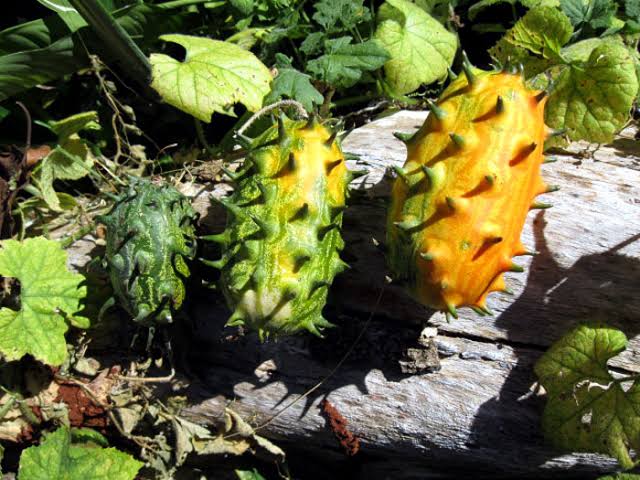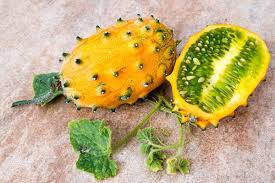Horned melons, scientifically known as Cucumis metuliferus, are unique fruits that captivate with their vibrant appearance and intriguing taste. Originating from the Kalahari Desert in Africa, these spiky wonders have earned the nickname “African horned cucumber” or simply “Kiwano.” Their distinctive appearance, with orange spiky skin resembling horns, sets them apart in the world of fruits.
When you first encounter a Horned melon, you may be struck by its unusual exterior. The vibrant orange color and prominent spikes make it stand out in any fruit display. Despite its fierce appearance, the skin is not as tough as it looks. Beneath the spiky layer lies a juicy, lime-green flesh that’s both refreshing and mildly sweet.
One remarkable aspect of Horned melons is their versatility. Whether eaten fresh, added to fruit salads, or incorporated into various dishes, the Kiwano brings a unique flavor to the table. Its taste is often described as a combination of cucumber, banana, and lime, offering a delightful and unexpected fusion of flavors.
In addition to its culinary appeal, Horned melons also boast nutritional benefits. They are a good source of essential nutrients, including vitamins A and C, potassium, and dietary fiber. These elements contribute to overall well-being and make the Kiwano a healthy addition to your diet.
Cultivating Horned melons requires specific conditions. They thrive in warm climates with well-drained soil and plenty of sunlight. The vines produce small, yellow flowers that eventually give way to the spiky fruits. The cultivation process requires patience, but the reward is a harvest of these exotic and visually striking fruits.
As global appreciation for diverse and unique fruits grows, the Horned melon continues to capture the curiosity of food enthusiasts. Its engaging appearance, combined with its intriguing taste profile, makes it a conversation starter and a favorite among those seeking new and exotic culinary experiences. So, next time you encounter a Horned melon, don’t be intimidated by its spiky exterior—slice it open and savor the delightful surprise that awaits within.
Read Also: Milk Processing and Storage Methods
The History of Horned Melon (Kiwano)

Horned melons, scientifically known as Cucumis metuliferus, have a history rooted in the vast landscapes of the Kalahari Desert in Africa. Indigenous to this region, the fruit has been cultivated and consumed by local communities for centuries.
The Kalahari Desert, known for its arid climate and challenging conditions, provided a unique environment for the Horned melon to evolve and adapt. The plant developed spiky skin, which serves as a protective layer against the harsh sun and potential predators. This adaptation allowed the fruit to thrive in the challenging conditions of its native habitat.
The indigenous people of the Kalahari Desert have long recognized the Horned melon as a valuable food source. Its water-rich flesh provided essential hydration in the arid landscape, and the nutritional content offered a supplement to their diet. Over time, these communities discovered the fruit’s versatile nature, incorporating it into various culinary practices.
While the Horned melon has deep roots in African history, its introduction to the wider world occurred later. With globalization and increased exploration, the fruit gradually made its way to different parts of the globe. Its striking appearance and unique taste sparked interest among those seeking novel and exotic fruits.
In the modern era, Horned melons have become a global phenomenon, cultivated in various regions with suitable climates. The fruit’s journey from the Kalahari Desert to international markets highlights the interconnectedness of cultures and the shared appreciation for diverse and distinctive foods.
Today, the Horned melon is not just a local delicacy but also a symbol of culinary diversity, celebrated for its visual appeal and intriguing flavor. Its rich history, deeply intertwined with the African landscape, adds a layer of cultural significance to this exotic fruit, making it a fascinating subject for those interested in the stories behind the foods we enjoy.
The Nutritional Values of Horned Melon (Kiwano)

Horned melons, scientifically known as Cucumis metuliferus, offer a variety of nutritional benefits. Despite their exotic appearance, these fruits pack a surprising punch of essential nutrients. Here’s a glimpse into the nutritional values of Horned melons:
1. Vitamins: Horned melons are a good source of vitamins, particularly vitamin A and vitamin C. Vitamin A is essential for vision, immune function, and skin health, while vitamin C acts as an antioxidant and supports the immune system.
2. Minerals: The fruit contains minerals like potassium, which plays a crucial role in maintaining proper heart and muscle function. Additionally, potassium helps regulate fluid balance in the body.
3. Dietary Fiber: Horned melons are rich in dietary fiber, promoting digestive health and aiding in the prevention of constipation. Fiber also contributes to a feeling of fullness, which can be beneficial for those watching their weight.
4. Calories: The fruit is relatively low in calories, making it a healthy snack option for those mindful of their calorie intake. This characteristic, combined with its refreshing taste, makes it a guilt-free treat.
5. Hydration: With its high water content, Horned melon serves as a hydrating fruit. Staying well-hydrated is essential for various bodily functions, including temperature regulation and nutrient transport.
6. Antioxidants: The presence of antioxidants in Horned melons helps combat oxidative stress in the body. Antioxidants play a role in reducing the risk of chronic diseases and supporting overall well-being.
It’s important to note that the specific nutritional content can vary slightly based on factors such as ripeness and growing conditions. However, incorporating Horned melons into your diet can be a flavorful way to enjoy a range of essential nutrients, contributing to a balanced and health-conscious lifestyle.
Read Also: The History and Origin of Highland Cows
Health Benefits of Horned Melon (Kiwano)

Horned melons, scientifically known as Cucumis metuliferus, offer several health benefits that make them a valuable addition to a balanced diet:
1. Hydration: With a high water content, Horned melons are effective in keeping the body hydrated. Proper hydration is essential for various bodily functions, including temperature regulation, nutrient transport, and overall well-being.
2. Rich in Vitamins: These fruits are a good source of essential vitamins, particularly vitamin A and vitamin C. Vitamin A is vital for maintaining healthy skin, vision, and immune function, while vitamin C acts as an antioxidant, supporting the immune system and protecting cells from damage.
3. Dietary Fiber for Digestive Health: Horned melons are rich in dietary fiber, promoting digestive health. Fiber aids in preventing constipation, supports a healthy gut microbiome, and may contribute to weight management by providing a feeling of fullness.
4. Potassium for Heart Health: The presence of potassium in Horned melons is beneficial for heart health. Potassium helps regulate blood pressure, reducing the risk of cardiovascular issues and supporting proper muscle and nerve function.
5. Antioxidant Properties: The fruit contains antioxidants that help neutralize free radicals in the body, reducing oxidative stress. Managing oxidative stress is associated with a lower risk of chronic diseases and supports overall health.
6. Low-Calorie Snack Option: Horned melons are relatively low in calories, making them a healthy snack choice for those looking to manage their calorie intake. Their refreshing taste and low calorie content make them an appealing alternative to more calorie-dense snacks.
While enjoying the unique flavor of Horned melons, individuals can also benefit from the nutritional components that contribute to overall health. As with any food, incorporating a variety of fruits and vegetables into a well-rounded diet is key to reaping the full spectrum of health advantages.
How to Grow Horned Melon (Kiwano)
Growing Horned melons, scientifically known as Cucumis metuliferus, can be a rewarding experience. Here’s a simple guide to help you cultivate these unique fruits:
1. Climate: Horned melons thrive in warm climates with temperatures between 70-100°F (21-38°C). They are sensitive to frost, so it’s crucial to plant them when the risk of frost has passed.
2. Soil: Well-draining soil is essential for Horned melons. A slightly acidic to neutral soil pH between 6.0-7.0 is optimal. Adding organic matter, like compost, can enhance soil fertility.
3. Planting: Start by planting Horned melon seeds indoors in biodegradable pots a few weeks before the last expected frost. Transplant the seedlings outdoors once the soil has warmed and all danger of frost has passed.
4. Sunlight: Horned melons require full sunlight for optimal growth. Choose a location in your garden that receives at least 6-8 hours of direct sunlight per day.
5. Watering: Keep the soil consistently moist but not waterlogged. Water deeply, especially during dry periods, and avoid overhead watering to prevent fungal issues.
6. Support: Horned melon vines can be sprawling, so providing support, such as trellises or cages, can help keep the fruits off the ground and make harvesting easier.
7. Pollination: Horned melons typically require both male and female flowers for pollination. Bees and other pollinators play a crucial role in this process. If you’re growing them indoors, manual pollination may be necessary.
8. Harvesting: Harvest Horned melons when the skin turns orange, and the spines are firm but not overly sharp. The fruit should yield slightly to gentle pressure. Overripe fruits may have a bitter taste.
9. Storage: Horned melons can be stored at room temperature for a few days until fully ripe. Once ripe, refrigerate to extend their shelf life.
10. Pests and Diseases: Keep an eye out for common pests such as aphids and cucumber beetles. Implementing organic pest control methods and practicing crop rotation can help manage potential issues.
Read Also: Healthy reasons why you should be taking enough Water

